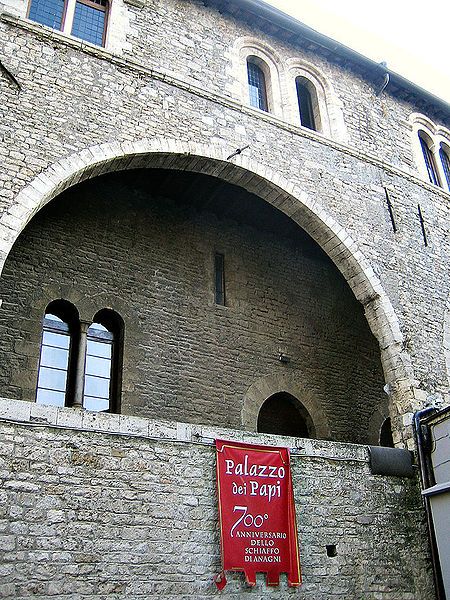Welcome to the city of Anagni, also known as the City of Popes. Located in the southern part of Lazio and easily reached by train from the Termini station, Anagni is a focal point in Italy’s medieval history. Indeed, it is here that Boniface VIII proclaimed the first Jubilee in history and it is in this same court he resided in for many years –at least until the night of the “slap”. Anagni could be a nice choice when travelling from Rome to Naples.
The incident that occurred between the Pope and the king of France, Philip the Fair, took place in 1303 inside the palace now known as the Palace of Boniface VIII. Today it houses the imposing Monastery of the Sisters of the Cistercian Congregation, founded by Sister Claudia De Angelis, a mystical Anagni native of the eighteenth century.

But it is not just this story which makes the city of Anagni important.
By strolling up Via Vittorio Emanuele, one of the main streets that connects two of the four doors allowing access to the city (Porta Cerere and Porta St Maria), it is possible to visit many notable buildings: the Anagni Town Hall, the auditorium, the church of St Andrew and the House of Barnekow, also called House of the Lilies. It is along this same path that we find two of the main structures of the city: the Palace Boniface VIII and the Cathedral of Anagni and its crypts.

The Palace is a huge complex of stone and wood that shows off the power accorded to popes during the Middle Ages; the papal residence was not simply a resort but also a fortress capable of defending him. From the outside, the majority of the Palazzo presents itself as a typical baronial residence from the early thirteenth century. It has two large stone arches, a lateral external staircase giving access to the first floor and, on the upper part, five lancet windows that serve three functions: beautifying the façade, giving light to the inside and unburdening the wall structure. The palace is open every day and entry is € 3.00 without guide.
In the Piazza Innocenzo III, you will see the Anagni Cathedral. Begun in 1073 and completed in 1104, around the same period as the Palace of Boniface VIII, this beautiful Romanesque edifice boasts an imposing castle-like architecture and a beautifully-preserved crypt covered in medieval frescoes.
Unlike the cathedral, which is always open and allows visitors to take photos, reproductions are prohibited in the crypt. That said, a guide will accompany you on the inside, showing you the major works you will find.

If you are in a group, it is recommended to make reservations because while the cathedral is very large, the crypt below only allows a maximum of thirty people. Furthermore, visits are limited to fifteen minutes, after which the lights that illuminate the frescoes are switched off automatically to ensure the maintenance of the climate in the room.
The ceilings, the walls, the columns; everything inside the crypt is painted, covering an area of about 450 square meters. The paintings are credited to three different masters, though their names have been lost to history. Not only are there three different styles within the crypt, but also three cycles –or themes– that the paintings narrate: the Cycle of the Apocalypse, the Cycle of the Alliance, and the Cycle of Science.

In truth, the frescoes tell the theory of the elements of Plato, discussed by Galen and Hippocrates. This theory explains the birth of the world in a scientific way: from the union of the four elements emerged the macrocosm (the world) and the microcosm (man). Both are part of the cyclical nature of life, which always has four phases: the seasons, the ages of man, the elements and the human temperaments (sanguine, choleric, melancholic and phlegmatic).
So whether you are staying in the capital or you are travelling from Rome to Naples, consider making Anagni one of your must-see cities !
Photos by Antmoose and Livioandronico2013, from Wikipedia Creative Commons


